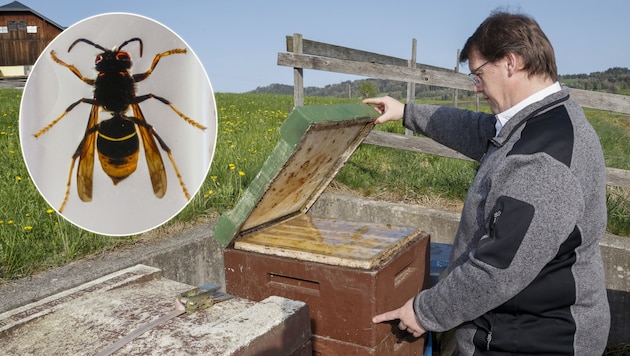Nasty bee killer!
Trembling before the bee killer
A single swarm of the Asian hornet can eat hundreds of bees every day. Now the six-legged killer has been spotted for the first time in Salzburg. Beekeepers are up in arms.
He had a watchful eye and made a very special discovery. A man recently discovered an unusual-looking insect on the grounds of the Christian Doppler Clinic. He caught the animal and laboratory analyses confirmed his initial suspicions. It was an Asian hornet ("Vespa velutina"). It is the first confirmed sighting in the whole of Austria.
This premiere is no cause for celebration: the introduced insect is a massive threat to native bees. "The hornets literally hunt them. A single swarm can eat hundreds of bees every day," says Andreas Brieger, regional chairman of the Salzburg Beekeepers' Association. What's more, the Asian hornet reproduces far faster than its domestic counterparts. "In France, there are now huge problems with the Vespa velutina. In some areas, beekeeping has come to a complete standstill," says Brieger.
What gives hope: the hornet found in Salzburg was a queen. Brieger: "It's a good thing we caught her. Otherwise the animal would be building a nest now. Then we would have a real problem in summer." The most dangerous thing about the Asian hornet is probably the fact that the entire beekeeping industry can come to a standstill "if we don't act properly", says master beekeeper Thomas Renner. Why? Because this animal needs an enormous amount of protein for its brood and it gets this by eating bees.
In the coming days, the beekeepers' association plans to set up live traps on the grounds of the Doppler Clinic. The aim is to find out whether only one Asian hornet is actually up to mischief here. The costs will be borne by the province of Salzburg.
Citizens should report sightings of the Asian hornet
The beekeepers are relying on the help of the public in their fight against the Asian hornet. Anyone can report a sighting unbureaucratically on the Internet(www.bienengesundheit.at).
What does the Vespa velutina look like? It is almost the same size as the native hornet, but has a striking black abdomen and yellow leg tips. "We have to take this seriously, but there's no need to panic," emphasizes Brieger. After all, unlike bees, the Asian hornet is no more dangerous to humans than its native counterpart.












Kommentare
Liebe Leserin, lieber Leser,
die Kommentarfunktion steht Ihnen ab 6 Uhr wieder wie gewohnt zur Verfügung.
Mit freundlichen Grüßen
das krone.at-Team
User-Beiträge geben nicht notwendigerweise die Meinung des Betreibers/der Redaktion bzw. von Krone Multimedia (KMM) wieder. In diesem Sinne distanziert sich die Redaktion/der Betreiber von den Inhalten in diesem Diskussionsforum. KMM behält sich insbesondere vor, gegen geltendes Recht verstoßende, den guten Sitten oder der Netiquette widersprechende bzw. dem Ansehen von KMM zuwiderlaufende Beiträge zu löschen, diesbezüglichen Schadenersatz gegenüber dem betreffenden User geltend zu machen, die Nutzer-Daten zu Zwecken der Rechtsverfolgung zu verwenden und strafrechtlich relevante Beiträge zur Anzeige zu bringen (siehe auch AGB). Hier können Sie das Community-Team via unserer Melde- und Abhilfestelle kontaktieren.